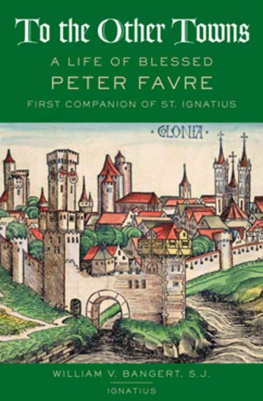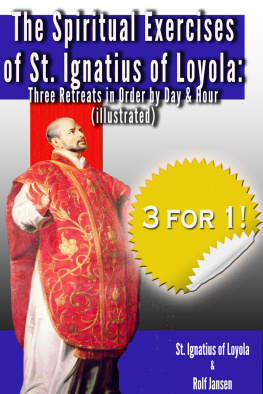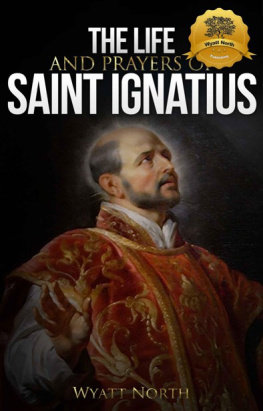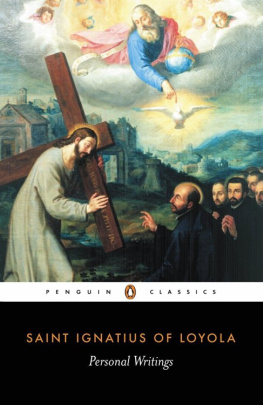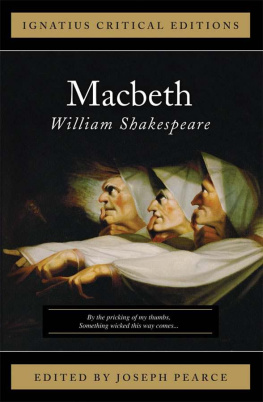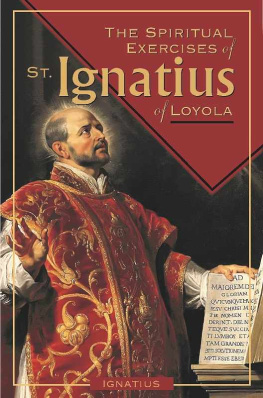TO THE OTHER TOWNS
But he said to them, To the other towns also I must proclaim the kingdom of God .Luke 4:43 Parece que no es nacido para estar quedo en una parteHe seems to have been destined to be ever on the move .Letter of Father Bartholomew Ferron to Father Santa Cruz, February 19, 1546
WILLIAM V. BANGERT, S.J.
TO THE
OTHER TOWNS
A Life of Blessed Peter Favre:
First Companion
of
Saint Ignatius
IGNATIUS PRESS SAN FRANCISCO
Originally published by The Newman Press
1959 by The Newman Press
Published with ecclesiastical approval, 1958
Cover art: Woodcut print of medieval town of
Cologne, Germany, ca. 1493
from Liber Chronicarum , compiled by Hartmann Schedel
CORBIS
Cover design by Roxanne Mei Lum
Published by Ignatius Press, San Francisco, 2002
ISBN 0-89870-918-0
Library of Congress Control Number 2001095551
Printed in the United States of America
To the Scholastics of the Society of Jesus whom it has been my privilege to teach .
CONTENTS
ABBREVIATIONS
I. Volumes of the Monumenta Historica Sodetatis Jesu :
Chron. SJ. Vita Ignatii Loiolae et Rerum Sodetatis Jesu Historic Auctore Joanne Alphonso de Polanco .
Eli Epistolae Paschasii Broeti, Claudii Jaji, Joannis Coduri et Simonis Rodericii .
EM Epistolae Mixtae .
EX Epistolae S. Francisci Xaverii .
FN Pontes Narrativi de S. Ignatio de Loyola et de Sodetatis Jesu Initiis .
MB Sanctus Franciscus Borgia .
ME Fabri Monumenta .
MI Series I: Sandi Ignatii de Loyola Epistolae et Instructiones.
Series II: Exercitia Spiritualia.
Series III: Sandi Ignatii de Loyola Constitutiones Sodetatis Jesu.
Series IV: Scripta de Santo Ignatio de Loyola.
MN Epistolae P. Hieronymi Nadal .
MR Patris Petri de Ribadeneira Confessiones, Epistolae Aliaque Scripta inedita .
II. Other Volumes:
AHSJ Archivum Historicum Sodetatis Jesu. AS Acta Sanctorum .
CR Corpus Reformatorum .
EC Beati Petri Canisii Epistolae et Acta .
PREFACE
F ATHER JEROME NADAL, Saint Ignatius alter ego in the promulgation of the Constitutions of the Society of Jesus, had the practice at the Communion of his Mass of praying for the grace to imitate Ignatius, Peter Favre, and Francis Xavier. In Nadals mind they were three names to be grouped together. The one suggested the other two. He was of course thinking as a contemporary of the events that had created this trio at the very origins of the Society. In the four centuries since Nadals time there has been a change, and people who now reflect on Jesuit beginnings usually think of them as the achievement of Loyola and Xavier. With the passage of time clarity of perspective has been lost, and the sharp, clear lines of Favres part in the foundation and extension of the Society so distinctly seen by Father Nadal and others, have become blurred.
Peter appears of course in all the biographies of Saint Ignatius and Saint Francis. Invariably he is presented as an especially attractive and congenial companiongentle, modest, lovable. But once his story takes him away from Rome in 1539 and his immediate association with Ignatius, hardly a word more is said about him until the recording of his death on August 1, 1546. Yet during those seven years of ceaseless travel, with journeys into northern Italy, the Netherlands and Portugal, into Spain twice and Germany three times, Peter was hard at work helping to lay Jesuit foundations in all those countries. Surrounding him in his constant labor there was ever an aura of prayerfulness, which made him par excellence the contemplative in the midst of work envisaged by Saint Ignatius as the ideal for his sons. Father Nadals perspective is the true one; it is the purpose of this work to recreate, in at least a partial way, that perspective.
The only full-scale life of Blessed Peter in English is the translation by Father H. J. Coleridge, S.J., of Father Giuseppe Boeros Vita del Beato Pietro Fabro , published in 1873. Father Boeros Vita , as well as the works by other nineteenth-century authors, such as Maurel, Prat, and Cornely, contains some rather seriously misleading errors. The present work, attempting as it does to correct these errors, is nevertheless not the definitive biography of Blessed Peter. Before that can be written much research must yet be done in Europes libraries. Saint Peter Canisius has had his Braunsberger. Saint Francis Xavier has his Schurhammer. Blessed Peter still awaits the scholar of like competence and industry to round out the task that has been so excellently begun by the editors of the Monumenta Fabri .
The chief source for the material of this biography has been the volumes of the Monumenta Historica Sodetatis Jesu . The number of people in Europe to whom I am in debt for kind help is proof of how difficult it has been to write this work on this side of the Atlantic. M. R. Avezou, Chief Archivist of the Dpartement de LIsre, and M. Franois Cochat, late Director of the Muse Municipal de Thnes, were most generous and exquisitely courteous in supplying me with information about the geography, the history, and general background of Villaret, Blessed Peters birthplace. Father Otto Pies, S.J., Tertian Instructor at Minister, loaned me an essential work, Ein Seelensoberer: Lebenserinnerungen des ersten flmischen Jesuiten Komelius Wischaven , by Alphons Kleiser, S.J. Father George Schurhammer, S.J., put me on the trail of an important unpublished document in the Jesuit Archives in Rome. Father Olphe-Galliard, S.J., graciously had microfilmed for me the notes of Father Cros now in the archives of the Toulouse Province of the Society of Jesus. Father Lehergne, S.J., did the same with several pages of Blessed Peters notebook, presently preserved in the archives of the Province of France. M. Alain Dufour, Librarian at the Bibliothque Publique et Universitaire de Genve, kindly sent to me the microfilmed copies of the notes of Thophile Dufour on the book Modus Componendi Epistolas , written by Peter Veillard, Blessed Peters teacher in Savoy. Canada has also made a contribution. Father Emile Papillon, Tertian Instructor at Mont Laurier, PQ., let me see a precious work I could not find in the United States, Nicholas Orlandinis Forma Sacerdotis Apostolici expressa in exemplo Petri Fabri , the second edition of the first life of Blessed Peter ever written.
I have also had the unstinted help of the man who is probably next to no one in his knowledge of Blessed Peters Memorial , Father William J. Read, S.J. Intractable passages of Peters awkward and difficult Spanish yielded their meaning only after they were subjected to the not-to-be-denied probing of Father Herbert A. Musurillo, S.J. To all I express my sincere gratitude.
Saint Francis de Sales, who was enchanted by the memory of Peter Favre, once observed that Peters life, when written, would be all honey and sweetness of devotion. No surer way of achieving that peculiar dulcedo can be found than to let Peter speak for himself in his letters and his spiritual diary or Memorial . This is the justification for the many and lengthy quotations.
WILLIAM V. BANGERT S.J.
Saint Andrew-on-Hudson
Poughkeepsie, New York
I
Of Books and of Sheep
I N THE increasingly nationality-conscious world of the early sixteenth century there rested on Frances southern borders two territorial anachronisms, remnants of the passing feudal world, the kingdom of Navarre and the duchy of Savoy. Both lay astride great mountain ranges, Navarre, touching France and Spain on either side of the Pyrenees, and Savoy, touching France and Italy on either side of the Alps. On April 7, 1506, in the castle of Xavier, secure in the mountain passes of Navarre, Dona Maria Xavier gave birth to her third son, Francis. Six days later, in the village of Villaret, hidden in the Alpine defiles of Savoy, Marie Prissin Favre brought into the world a boy whom she named Peter. Nineteen years later Francis, the nobleman, and Peter, the shepherd, left their homes for the University of Paris. At the University they became roommates and dear friends. There it was that Ignatius of Loyola met them both and won them to his intensely ardent ideal of following Christ. Ignatius quarried well when he cut from the mountainsides of Navarre and Savoy the first stones for the edifice that one day would become the Society of Jesus.
Next page
